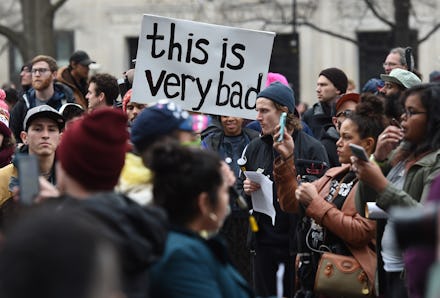Donald Trump's isolationism on NAFTA and TPP is for his base — and that's exactly whom it will hurt

On Friday President Donald Trump made a central inauguration speech promise to end the "ravages of other countries making our products, stealing our companies and destroying our jobs" — a protectionist pledge seemingly directed at the blue collar American workers that comprised his voter base.
On Monday, Trump wasted no time, with planned executive orders that would begin withdrawing from and rethinking trade agreements: One new, one old.
Trump looks to withdraw from the pending Trans Pacific Partnership — which would have increased trade with Asian, South Pacific and North and Latin American countries — and potentially renegotiate the long-standing North American Free Trade agreement, or NAFTA, according to an Axios report.
While axing these deals or increasing tariffs might, on paper, seem to benefit American workers — by incentivizing consumers to buy U.S. products instead of foreign-made ones — other negative effects could result, hurting U.S. consumers and even manufacturers.
Since 1994, for example, NAFTA has facilitated trade with Canada and Mexico — aka the two biggest U.S. trade partners by value of exported goods (the stuff the U.S. sells abroad).
Indeed, Mexico made it clear Monday morning that any move that would punish the nation's businesses in favor of American ones would be met with a "mirror action" to punish U.S. exporters.
Now, there's little doubt that those Trump supporters who feel American jobs have declined and that they have been left behind economically have reason to be upset.
The recovery of jobs since the financial crisis has been incredibly uneven.
As you see below in the graphic from Bloomberg, much of the job gains over President Barack Obama's tenure (in green) were concentrated in urban and coastal areas. Far more jobs were created than lost, but it's easy to find places on the map where it doesn't feel like that (in red) — by a long shot.
To use one example, check out West Virginia in the map — a state with a Democratic senator, a state that chose Trump over Democratic nominee Hillary Clinton by a margin of 2-to-1 — you can see why so many people found Trump's message of isolationism played so well.
The thing is, while Trump may have successfully tapped into the resentment U.S. workers feel toward the countries that "steal" American jobs, the president misdiagnoses the causes for and solutions to the precipitous declines in U.S. manufacturing industries.
Even conservative think tanks, like the Heritage Foundation, and conservative icons like Bill Kristol, the Weekly Standard editor at large who worked in the administrations of former presidents Ronald Reagan and George H. W. Bush, argue that free trade is a net positive for the United States.
Trump promised to put "America first," and creating tax incentives so people "buy American" may seem like it would help achieve that goal. But in reality, cutting off trade is unlikely to help people whose jobs have already been displaced — or lost to automation.
Even the stock market — which seemed to be warming up to some of Trump's business-friendly policies like cutting taxes — took a dip as Trump began talking about "American carnage" on Friday; the S&P 500 and Dow Industrial Average remained slightly down for the month as of Monday midday.
Why the gloom from investors?
Loads of evidence suggests that protectionism can backfire by making cheap goods more expensive.
Lower-income and middle-class Americans, who rely on cheap goods disproportionately, will feel these side effects most acutely.
Research also suggests trade agreements are a two-way street: The nonpartisan Woodrow Wilson Center has found that 40 cents out of every dollar spent on Mexican imports comes straight back into the United States, because the U.S. is often providing raw materials or component parts.
Then there's the jobs to consider.
For all Trump's talk of helping lift up America's struggling manufacturing sector, ditching NAFTA may have the opposite effect: The Center for Automotive Research recently estimated that doing so could cost up to 30,000 auto jobs.
In short, just like other early Trump administration initiatives — like moving to cut arts funding — trade barriers are more likely to hurt rural Americans than coastal elites.
Now, enough about problems.
If getting rid of trade deals is unlikely to lead to higher wages, what will? What are real solutions for jobless Americans?
Better leverage for workers, better funding for universities and more college and vocational training would all be a good start.
Other proposed solutions — that wouldn't incite trade war — include lower barriers to occupational licensing (e.g., do manicurists really need 600 hours of training?); better incentives for companies to invest in hiring and R&D (as opposed to, say, stock buybacks); easier immigration by skilled foreign entreprenuers (who tend to create, rather than destroy jobs); and decreasing income inequality, since 70% of the American economy is consumer-driven.
And it pays to look at history: America has tried the isolationist experiment before. After World War I, to an understandably battle-weary and wildly unequal country, isolationism sounded pretty good too.
A movement to pacify the Nazis — also named "America First" — quickly devolved into rabid anti-Semitism.
Here is hoping Trump learns from those lessons sooner than later.
Sign up for The Payoff — your weekly crash course on how to live your best financial life.